Sensor Sweep: Travis McGee, Tomahawks, Rome: Total War
Monday , 25, April 2022 Sensor Sweep Leave a commentRPG (Walker’s Retreat): Games are created from distinct parts and histories that merge together to form a new set of rules for the gamers to conquer. A game is defined by its rules which the players work with in order to beat. In essence, you should only need one rulebook or instruction manual to understand how to play a game. Why would you ever need more than one unless the game is either broken, or the people who made it want to syphon more money off of you?
Weapons (Guns America): A gun is only as good as the number of bullets you have on hand. Once you run out, you’re out. Which is why many of us also carry an edged weapon on our person. Not our primary fighting tool but it’s there in a pinch. For some, though, the ideal situation is to marry these two systems. To mount your blade on your gun.
you have on hand. Once you run out, you’re out. Which is why many of us also carry an edged weapon on our person. Not our primary fighting tool but it’s there in a pinch. For some, though, the ideal situation is to marry these two systems. To mount your blade on your gun.
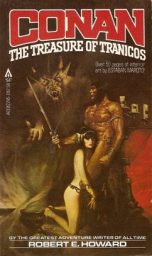 Conan (Sprague de Camp Fan): “The Treasure of Tranicos” was first published under the title “The Black Stranger” in Fantasy Magazine, March 1953. It was reprinted as “The Treasure of Tranicos” for King Conan, Gnome Press, 1953. It was revised and re-published as the first story in Conan the Usurper, Lancer Books, 1967. Conan the Usurper was the fourth book published in the series but is the 8th chronologically.
Conan (Sprague de Camp Fan): “The Treasure of Tranicos” was first published under the title “The Black Stranger” in Fantasy Magazine, March 1953. It was reprinted as “The Treasure of Tranicos” for King Conan, Gnome Press, 1953. It was revised and re-published as the first story in Conan the Usurper, Lancer Books, 1967. Conan the Usurper was the fourth book published in the series but is the 8th chronologically.
Review (With Both Hands): Remains is the most fun I’ve had with a Galaxy’s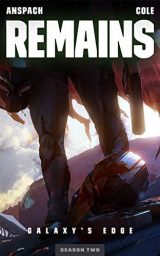 Edge book in a while. We get a whole book focused on the 131st Legion’s invasion of Kima, which means we get to see Cohen Chhun’s newly restored Legionnaires do what they do best: kill people and break stuff in spectacular fashion. And now there aren’t any points around to tell Chhun that he can’t order an orbital bombardment….
Edge book in a while. We get a whole book focused on the 131st Legion’s invasion of Kima, which means we get to see Cohen Chhun’s newly restored Legionnaires do what they do best: kill people and break stuff in spectacular fashion. And now there aren’t any points around to tell Chhun that he can’t order an orbital bombardment….
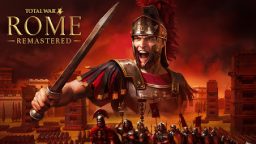 Games (Wertzone): You could make a good argument that late 2004 was one of the greatest periods for video game releases ever. In rapid succession, Grand Theft Auto: San Andreas, World of WarCraft, Half-Life 2, Counter-Strike: Source, Halo 2, Vampire: The Masquerade – Bloodlines and Knights of the Old Republic II were released to a joyful public. Also in that mix was Rome: Total War.
Games (Wertzone): You could make a good argument that late 2004 was one of the greatest periods for video game releases ever. In rapid succession, Grand Theft Auto: San Andreas, World of WarCraft, Half-Life 2, Counter-Strike: Source, Halo 2, Vampire: The Masquerade – Bloodlines and Knights of the Old Republic II were released to a joyful public. Also in that mix was Rome: Total War.
Robert E. Howard (John C. Wright): God in the Bowl did not see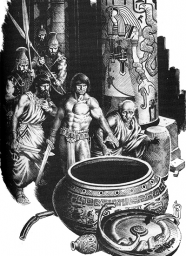 publication until appearing in the pages of Space Science Fiction, September 1952, after it had been partly rewritten, perhaps to its detriment, by L. Sprague de Camp. The previous story in the Conan Canon, Red Nails, appeared in the September 1936 issue of Weird Tales: a gap of sixteen years.
publication until appearing in the pages of Space Science Fiction, September 1952, after it had been partly rewritten, perhaps to its detriment, by L. Sprague de Camp. The previous story in the Conan Canon, Red Nails, appeared in the September 1936 issue of Weird Tales: a gap of sixteen years.
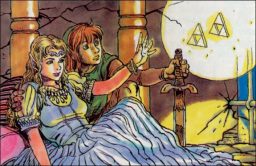 Art (Overmental): We fondly remember Nintendo Power for a lot of reasons, but Zelda fans in particular will instantly recognize the artwork below.
Art (Overmental): We fondly remember Nintendo Power for a lot of reasons, but Zelda fans in particular will instantly recognize the artwork below.
These pieces were the work of a Japanese artist named Katsuya Terada, who contributed a series of stunning Zelda inspired illustrations for the magazine and official player’s guides. It would be years before a Legend of Zelda could actually look this good, but Terada’s artwork went a long ways in helping to spark the imaginations of a generation of players who grew up on these games in the 90s.
Comic Books (Valdosta Daily News): In the Conan stories of Robert E. Howard, the barbarian seemed like a tremendously wily, strong, tough and agile man thrown into fantastic adventures. With Howard’s short story “A Witch Shall Be Born,” Conan arguably becomes a super-powered barbarian. Not just a man but a man with extraordinary strength and perseverance.
Reading (Ken Lizzi): I’ve been thinking about what books to purchase for Victoria Valentina. With what titles shall I stock her library? Honestly I’ve been pondering this since before she was born. Look, that’s just how I am. Don’t judge me.
I’ve already picked up a paperback copy of Tbe Wind in the Willows. She may be about a decade from appreciating that one. I read it aloud to my wife. It’s been more than thirty years since I’d last read it. It held up, though it is more ponderous and somewhat less whimsical than I remember.
Tolkien (Alas Not Me): At 49 pages, J.R.R. Tolkien’s Lost English Mythology is more of a monograph than a book. Yet its brevity makes it only more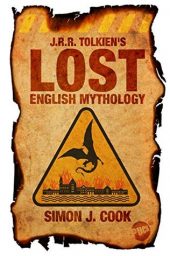 impressive. With admirable force and economy, Cook analyzes Middle-Earth as ‘an exploration of the ancient imagination of the North, forged from profound scholarship as well as literary genius, and situated on the threshold of actual history.’
impressive. With admirable force and economy, Cook analyzes Middle-Earth as ‘an exploration of the ancient imagination of the North, forged from profound scholarship as well as literary genius, and situated on the threshold of actual history.’
RPG (Matthew Constantine): The 2021 Free RPG 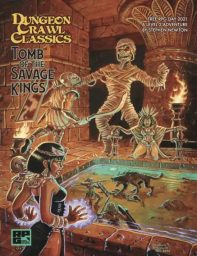 Day adventure for Dungeon Crawl Classics was Tomb of the Savage Kings, and it seems like a good deal of fun. This is an homage to some classic Mummy movies, specifically The Mummy (1933), The Mummy’s Hand (1940), and The Mummy (1959). As the 1933 film is a favorite of mine (second among Universal Horror only to Creature from the Black Lagoon), I was pretty jazzed to check this out.
Day adventure for Dungeon Crawl Classics was Tomb of the Savage Kings, and it seems like a good deal of fun. This is an homage to some classic Mummy movies, specifically The Mummy (1933), The Mummy’s Hand (1940), and The Mummy (1959). As the 1933 film is a favorite of mine (second among Universal Horror only to Creature from the Black Lagoon), I was pretty jazzed to check this out.
Science Fiction (M Porcius): For some time now I have owned a copy of the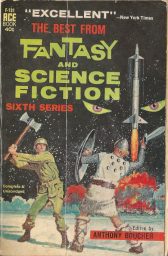 1962 paperback printing of The Best from Fantasy and Science Fiction: Sixth Series, an anthology edited by F&SF editor Anthony Boucher first published in 1957. In his introduction to the volume, Boucher takes issue with John W. Campbell, Jr.’s article in the May 12, 1956 issue of The Saturday Review (easily accessible at the world’s greatest website, the internet archive), in which Campbell argues that science fiction has different goals than conventional literature and should be judged on a different basis.
1962 paperback printing of The Best from Fantasy and Science Fiction: Sixth Series, an anthology edited by F&SF editor Anthony Boucher first published in 1957. In his introduction to the volume, Boucher takes issue with John W. Campbell, Jr.’s article in the May 12, 1956 issue of The Saturday Review (easily accessible at the world’s greatest website, the internet archive), in which Campbell argues that science fiction has different goals than conventional literature and should be judged on a different basis.
Science Fiction (Marzaat): “Ministry of Disturbance”, H. Beam Piper, 1958. This story was first published in the December 1958 issue of Astounding Science Fiction. It’s chockful of stuff on the First Empire of the Terro-Human Future History. We get the first mention of the Fuzzies and the Space Vikings of later Piper works. We have the technologies of semi-sentient robots and mediums of varying powers. We hear about the System States War which forms the background of “The Graveyard of Dreams”.
Lost Race (Fantasy Literature): The book in question this time is called The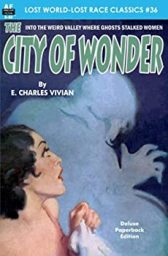 City of Wonder and was written by one E. Charles Vivian. A more impressively penned novel than Rousseau’s, the book combines the standard lost-world/lost-race tropes with a pleasing dollop of supernaturalism. And whereas the Rousseau novel had as its locale for those sea demons a very precise location in the Shetland Islands, Vivian’s book has as its location … well, I’m really not sure. More on this in a moment.
City of Wonder and was written by one E. Charles Vivian. A more impressively penned novel than Rousseau’s, the book combines the standard lost-world/lost-race tropes with a pleasing dollop of supernaturalism. And whereas the Rousseau novel had as its locale for those sea demons a very precise location in the Shetland Islands, Vivian’s book has as its location … well, I’m really not sure. More on this in a moment.
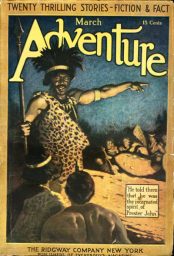 Magazine Art (Goodman Games): At its height, Adventure Magazine had a circulation of over 300 thousand and was published three times a month, marking it as one of the most successful fiction pulps of all time (in 1935 Time Magazine dubbed Adventure ‘The No. 1 Pulp’). Adventure gave the audience just what the title suggested; pulse-pounding tales set in exotic locales, desperate journeys on land and sea, western gunfights, jungle explorations, and blade-whirling exploits throughout history.
Magazine Art (Goodman Games): At its height, Adventure Magazine had a circulation of over 300 thousand and was published three times a month, marking it as one of the most successful fiction pulps of all time (in 1935 Time Magazine dubbed Adventure ‘The No. 1 Pulp’). Adventure gave the audience just what the title suggested; pulse-pounding tales set in exotic locales, desperate journeys on land and sea, western gunfights, jungle explorations, and blade-whirling exploits throughout history.
Art (DMR Books): I’ve always had a guilty fondness for 1980’s Hawk the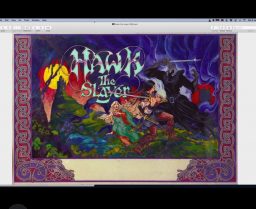 Slayer. I saw it as a kid and I thought it was kinda cool, despite all the cheesiness. Plus, Jack Palance. In addition, the movie poster—by Drew Struzan?—was solid.
Slayer. I saw it as a kid and I thought it was kinda cool, despite all the cheesiness. Plus, Jack Palance. In addition, the movie poster—by Drew Struzan?—was solid.
RPG (Goodman Games): Here in the Goodman Games world, we’ve been rediscovering the works of Harold Lamb. He wrote timeless adventure stories that influenced a bevy of Appendix N authors, most notably Robert Howard. The strength of Lamb’s tales are tight plotting, crisply drawn characters and rich historical detail. But as enjoyable as Lamb’s tales are, they lack some of the cardinal elements of Appendix N literature and DCC RPG adventures:
Cinema (Collider): Kurt Russell is iconic, Hollywood royalty, and one of the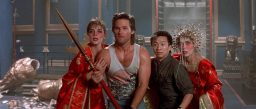 most admired actors in showbiz. The family man and all around good guy still manages to land roles in mainstream movies such as The Fast and the Furious franchise even though he’s now in his 70s, and recently he starred alongside partner of nearly 40 years, Goldie Hawn, as St. Nick in The Christmas Chronicles 2.
most admired actors in showbiz. The family man and all around good guy still manages to land roles in mainstream movies such as The Fast and the Furious franchise even though he’s now in his 70s, and recently he starred alongside partner of nearly 40 years, Goldie Hawn, as St. Nick in The Christmas Chronicles 2.
 Fiction (Pulp Net): Here we have The Chronicles of Solar Pons, which was published in 1973 by Mycroft & Moran as the seventh and “final” collection of August Derleth‘s Solar Pons stories. It was also published posthumously, as Derleth had passed away in 1971. As I understand it, he had finalized this work, even soliciting the introduction, before he passed.
Fiction (Pulp Net): Here we have The Chronicles of Solar Pons, which was published in 1973 by Mycroft & Moran as the seventh and “final” collection of August Derleth‘s Solar Pons stories. It was also published posthumously, as Derleth had passed away in 1971. As I understand it, he had finalized this work, even soliciting the introduction, before he passed.
Fiction (Dark City Underground): In 1964 JDM’s most iconic character – and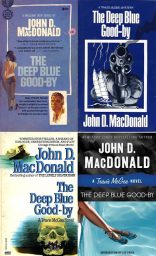 his only series character – the boat bum and salvage expert Travis McGee appeared in The Deep Blue Good-by, published as a paperback original by Gold Medal. McGee appeared in 21 novels between 1964 and 1984. Each of the McGee adventures featured a color – pink, amber, indigo, lavender – in the title and each book sold in the millions.
his only series character – the boat bum and salvage expert Travis McGee appeared in The Deep Blue Good-by, published as a paperback original by Gold Medal. McGee appeared in 21 novels between 1964 and 1984. Each of the McGee adventures featured a color – pink, amber, indigo, lavender – in the title and each book sold in the millions.
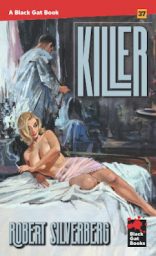 Fiction (Rough Edges): Many of the soft-core novels published by William Hamling in the late Fifties and on through the Sixties were crime novels, not surprising when you consider that some of the pseudonymous authors were writers such as Lawrence Block and Donald E. Westlake, who went on to be big names in the mystery/crime/suspense field. But Hamling had writers from other genres working for him, too.
Fiction (Rough Edges): Many of the soft-core novels published by William Hamling in the late Fifties and on through the Sixties were crime novels, not surprising when you consider that some of the pseudonymous authors were writers such as Lawrence Block and Donald E. Westlake, who went on to be big names in the mystery/crime/suspense field. But Hamling had writers from other genres working for him, too.
Weapons (Frontier Partisans): Well… I find the notion that there’s “no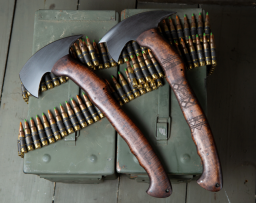 military purpose” for a “heavy, awkward” tomahawk pretty strange (I’m guessing Carr would, too). From New York to New Zealand from the 17th Century through the 19th Century, tomahawks or belt axes were part of virtually every native warrior or frontiersman’s kit. Clearly, some SEALs thought they were a bad look. Others thought differently. I guess a tomahawk might be seen as atavistic; I see it as Continuity & Persistence.
military purpose” for a “heavy, awkward” tomahawk pretty strange (I’m guessing Carr would, too). From New York to New Zealand from the 17th Century through the 19th Century, tomahawks or belt axes were part of virtually every native warrior or frontiersman’s kit. Clearly, some SEALs thought they were a bad look. Others thought differently. I guess a tomahawk might be seen as atavistic; I see it as Continuity & Persistence.
History (Isegoria): Jan Bloch was not a soldier. He was a banker who was born into poverty in Warsaw in 1836 but worked his way up to become a wealthy railroad financier in Russian-controlled Poland. He never served a day of his life in uniform. But he was passionate about military issues and for years obsessively studied how the new technologies of his era would change warfare.
Robert E. Howard (DMR Books): Robert E. Howard seems to have held a favorable opinion of the Suomi and their land. In a letter to H.P. Lovecraft in 1932, Robert E. Howard writes this: “Speaking of Mongol stocks, I notice the Finns seem to be somewhat divided among themselves, even to the point of violence. But as you say, they and the Hungarians have adapted themselves to western civilization surprizingly well for Mongolians.”
Please give us your valuable comment